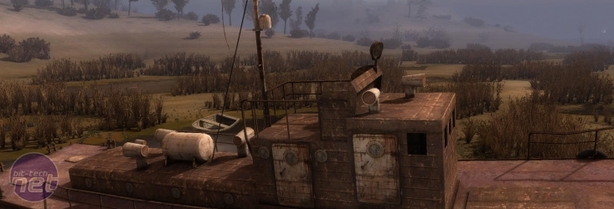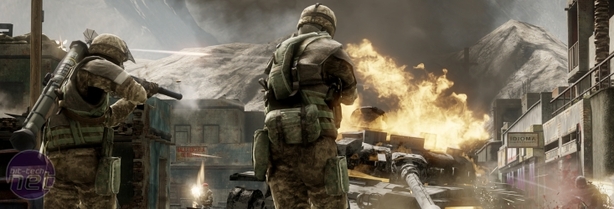
Results Analysis – Game Performance
The first game of our new test suite was Dirt 2, and the GTX 470 proved marginally faster than the Radeon HD 5870 in this game at most resolutions. At 1,920 x 1,200, the GTX 470 had a 2-3fps lead whether 4x AA was applied or not. However, at 2,560 x 1,600 the HD 5870 edged ahead, with a 4-6fps lead over the GTX 470 – as the game was playable on both cards, this performance drop-off isn’t of academic interest either, so this is a disappointment for the Nvidia hardware.While Dirt 2 proved a problem for the GTX 470 only at 2,560 x 1,600, STALKER: Call of Pripyat was a nightmare for the card at every resolution. The GTX 470 was outpaced by the HD 5870 by at least 10fps in every test, which equates to around a 30 per cent performance lead for the HD 5870 in Call of Pripyat. As we crank all the details of this game up to maximum (making this is a torture test for GPUs) this test serves as a great indicator as to the maximum abilities of a GPU. The fact that a lowly £220 Radeon HD 5850 is faster than the GTX 470 in this game is very embarrassing for Nvidia.

DoW II: Chaos Rising saw mixed results from the GTX 470 when compared to the HD 5870. When no AA was used, the HD 5870 was a notch faster by 3-6fps but the Radeon card was slower than the GeForce when we applied AA by between 3fps and 5fps. As the HD 5870 has greater memory bandwidth than the GTX 470 (154GB/sec rather than 134GB/sec) we can’t blame a skinny memory bus for the fluctuations in lead. However, we can say that the issue is more to do with ATI than Nvidia, as the GTX 470 holds its frame rate well after we applied AA while the HD 5870 didn’t. At 1,920 x 1,200, the GTX 470 managed a minimum of 28fps with no AA and of 24fps with AA; the minimum frame rate of the HD 5870 dropped from 34fps to 21fps, however.
Apart from one person, the entire bit-tech office though Crysis would run spectacularly well on the GTX 480 and GTX 470. Wow, were we wrong. The HD 5870 gave the GTX 470 a thorough beating in pretty much every test – only when we ramped the resolution up to 2,560 x 1,600 and started to see single-figure minimum frame rates did the GTX 470 prove slightly faster. For example, at 1,680 x 1,050 with no AA the HD 5870 managed a smooth 26fps minimum while the GTX 470 was stuttering along at a 21fps minimum. When we applied 4x AA, the HD 5870 was still slightly faster, with an extra 1fps on the minimum frame rate and 6fps on the average.
Nvidia advised us to check out the 8x AA performance of its new card, and we obliged. At 1,680 x 1,050 with 8x AA, the HD 5870 managed a minimum of 21fps to the 18fps minimum of the GTX 470. And yes, that is correct – the HD 5870 was actually faster in Crysis when applying 8x AA than when applying 4x (we checked the numbers, driver settings and the test rig itself to confirm). At resolutions above 1,680 x 1,050 neither the HD 5870 nor the GTX 470 couls play Crysis smoothly.

Battlefield: Bad Company 2 saw a return to the flipping between whether the the HD 5870 or the GTX 470 was the fastest. With no AA, the Radeon was between 3fps and 7fps faster than the GTX 470, while the GeForce card proved 5-7fps faster when we applied 4x AA. Again, it looks like the ATI card drops more performance than the Nvidia when trying to apply the AA – at 1,680 x 1,050 the HD 5870 managed a minimum of 59fps with no AA, but only of 42fps with 4x AA, which is a drop of 29 per cent. The GTX 470 held onto more of its minimum of 53fps when applying AA, with a drop of only 8 per cent to 49fps.
At 2,560 x 1,600 the situation was reversed, with the same kind of drop-off in performance from the GTX 470 when pushing this many pixels as we saw in Dirt 2. With no AA at this resolution, the HD 5870 could produce a minimum of 33fps compared to the 26fps minimum of the GTX 470. With 4x AA, the HD 5870 could just about manage a smooth minimum frame rate of 24fps while the GTX 470 was stuttering to a minimum of just 20fps.
Beyond Gaming
This review focuses entirely on what the GTX 480 is like to own for gaming PC, and we haven't touched on CUDA or PhysX performance, GPGPU uses or folding@home. We plan to investigate these uses over the next few weeks in dedicated in-depth articles, along with deeper investigations as to the tessellation capabilities of the Fermi architecture versus ATI's Cypress design. Stay tuned!
MSI MPG Velox 100R Chassis Review
October 14 2021 | 15:04








Want to comment? Please log in.